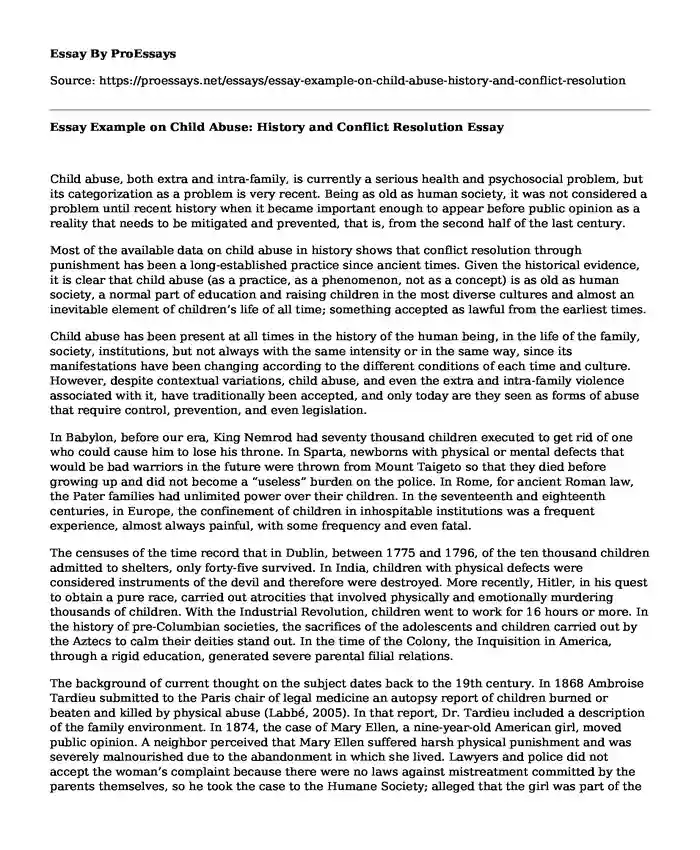Child abuse, both extra and intra-family, is currently a serious health and psychosocial problem, but its categorization as a problem is very recent. Being as old as human society, it was not considered a problem until recent history when it became important enough to appear before public opinion as a reality that needs to be mitigated and prevented, that is, from the second half of the last century.
Most of the available data on child abuse in history shows that conflict resolution through punishment has been a long-established practice since ancient times. Given the historical evidence, it is clear that child abuse (as a practice, as a phenomenon, not as a concept) is as old as human society, a normal part of education and raising children in the most diverse cultures and almost an inevitable element of children’s life of all time; something accepted as lawful from the earliest times.
Child abuse has been present at all times in the history of the human being, in the life of the family, society, institutions, but not always with the same intensity or in the same way, since its manifestations have been changing according to the different conditions of each time and culture. However, despite contextual variations, child abuse, and even the extra and intra-family violence associated with it, have traditionally been accepted, and only today are they seen as forms of abuse that require control, prevention, and even legislation.
In Babylon, before our era, King Nemrod had seventy thousand children executed to get rid of one who could cause him to lose his throne. In Sparta, newborns with physical or mental defects that would be bad warriors in the future were thrown from Mount Taigeto so that they died before growing up and did not become a “useless” burden on the police. In Rome, for ancient Roman law, the Pater families had unlimited power over their children. In the seventeenth and eighteenth centuries, in Europe, the confinement of children in inhospitable institutions was a frequent experience, almost always painful, with some frequency and even fatal.
The censuses of the time record that in Dublin, between 1775 and 1796, of the ten thousand children admitted to shelters, only forty-five survived. In India, children with physical defects were considered instruments of the devil and therefore were destroyed. More recently, Hitler, in his quest to obtain a pure race, carried out atrocities that involved physically and emotionally murdering thousands of children. With the Industrial Revolution, children went to work for 16 hours or more. In the history of pre-Columbian societies, the sacrifices of the adolescents and children carried out by the Aztecs to calm their deities stand out. In the time of the Colony, the Inquisition in America, through a rigid education, generated severe parental filial relations.
The background of current thought on the subject dates back to the 19th century. In 1868 Ambroise Tardieu submitted to the Paris chair of legal medicine an autopsy report of children burned or beaten and killed by physical abuse (Labbé, 2005). In that report, Dr. Tardieu included a description of the family environment. In 1874, the case of Mary Ellen, a nine-year-old American girl, moved public opinion. A neighbor perceived that Mary Ellen suffered harsh physical punishment and was severely malnourished due to the abandonment in which she lived. Lawyers and police did not accept the woman’s complaint because there were no laws against mistreatment committed by the parents themselves, so he took the case to the Humane Society; alleged that the girl was part of the animal kingdom and appealed to the law against cruelty to animals (Shelman & Lazoritz, 2005).
In 1953 Silverman described what he called “Unrecognized Skeletal Trauma” and suggested that the parents were quite possibly the authors (Castellani et al., 2017). Kempe and Silverman introduced the term “Beaten Child Syndrome” relating the injuries, generally with the parents or an adult who cared for the minor. In these children, a series of emotional disturbances, nutritional deficiency, negligence in their general attention, etc., were observed due to lack of adult attention. This phenomenon may or may not be accompanied by sexual abuse and physical abuse. Over time, new forms of abuse have been described, such as “Munchausen Syndrome” and “Fetal Abuse and Neglect.”
Conclusion
The phenomenon of child abuse is, therefore, as old as humanity itself, but the concept of child abuse is an absolute novelty of contemporary history.
References
Castellani, R. J., Joyce, L. D., & Schmidt, C. J. (2017). Homicidal abuse of young children: A historical perspective. Journal of Forensic Science and Medicine, 3(2), 97.
Child Welfare League of America (2019). Massachusetts’ Children at a Glance. https://www.cwla.org/wp-content/uploads/2019/04/Massachusetts-2019.pdf
Labbé, J. (2005). Ambroise Tardieu: The man and his work on child maltreatment a century before Kempe. Child abuse & neglect, 29(4), 311-324.
Shelman, E. A., & Lazoritz, S. (2005). The Mary Ellen Wilson child abuse case and the beginning of children's rights in 19th century America. McFarland.
Cite this page
Essay Example on Child Abuse: History and Conflict Resolution. (2023, Sep 10). Retrieved from https://proessays.net/essays/essay-example-on-child-abuse-history-and-conflict-resolution
If you are the original author of this essay and no longer wish to have it published on the ProEssays website, please click below to request its removal:
- Gang Violence in Washington DC Research
- The Wealthy Should Not Be Praised for Helping the Less Fortunate
- State of the U.S. Income Inequality Research Paper Example
- Interview With Mr. Smith Davis to Reduce Poverty in Country - Essay Sample
- Essay Example on Promoting Healthy Weights: Parent & School Interventions
- Facing the Pain of Violence and Crime: A Community Struggle - Essay Sample
- Essay Example on Women in Buddhism: Debates, History, and Feminism







